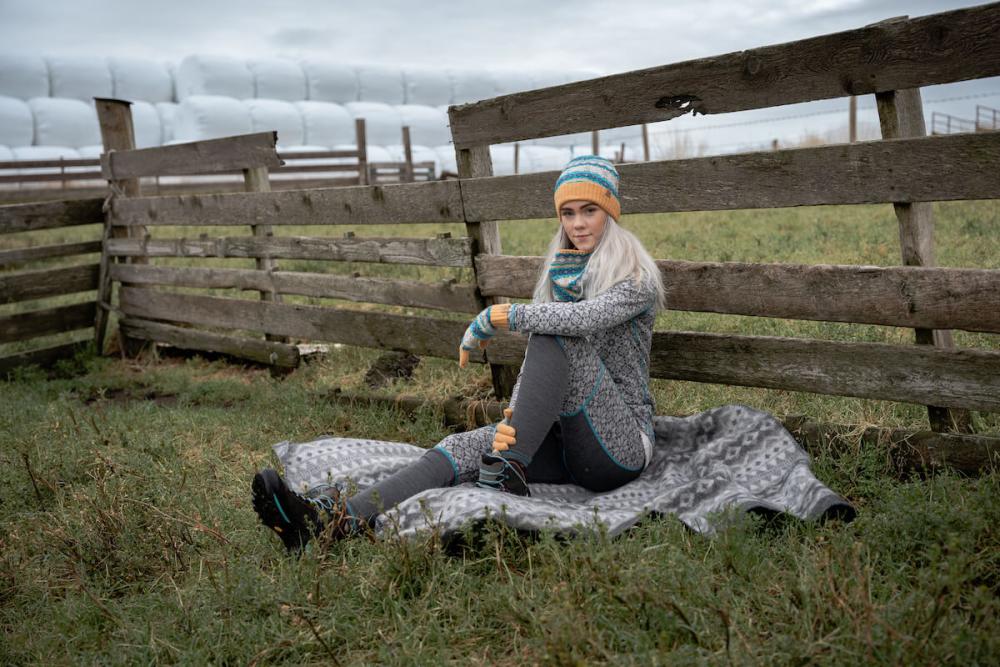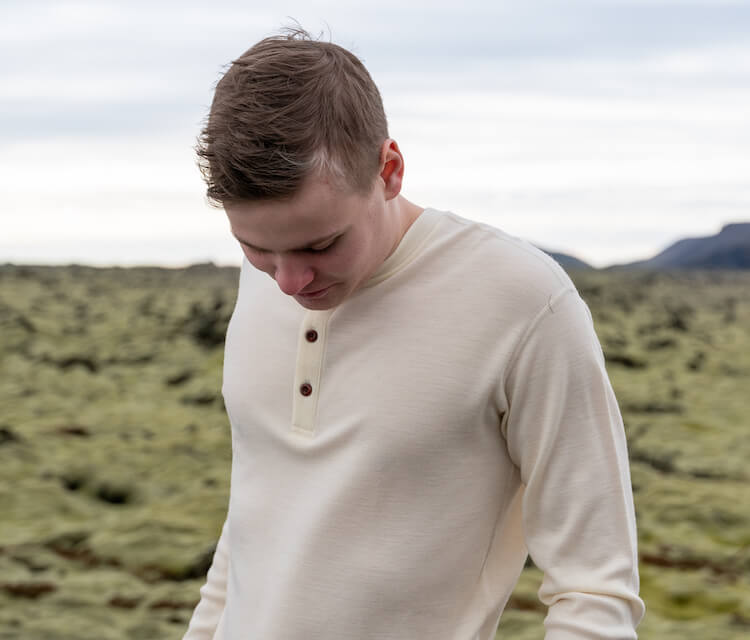Merino wool embraces you in the caress of a fine, soft fiber. What makes Merino wool unique is also what makes it perfectly suited for base layers and anything that requires a full range of movement. In outdoor wear, Merino wool is a game-changer.
CONTENT:
- How Merino Wool is Made
- 100% Merino Wool vs. Merino Wool Blends
- What is Merino wool best for?
- Is Merino wool itchy?
- How to Care for Merino Wool
- How to Wash Merino Wool
- Does Merino wool shrink?
- How to Store Merino Wool
- How to Shop Merino Wool by Weight (and Thickness)
Merino wool embraces you in the caress of a fine, soft fiber. What makes Merino wool unique is also what makes it perfectly suited for base layers and anything that requires a full range of movement. In outdoor wear, Merino wool is a game-changer.
The first thing most people think of with wool are warm, chunky scarves or knit sweaters. Merino wool challenges the stereotypes and surprises the senses.
Merino wool comes from Merino sheep. Though the fibers from Merino wool are known to be extremely fine, Merino sheep are actually a large and resilient breed. Merino sheep originated in Spain, but today most Merino sheep are raised in Australia and New Zealand.
One of the highest performing natural materials is Merino wool, but only if you know how to care for it. Keep reading to learn how Merino wool is made, how to compare 100% Merino to wool blends, what Merino wool is best for, and how to care for Merino wool.
How Merino Wool is Made
Merino wool is sheared once or twice a year from Merino sheep after they’re groomed and cleaned. Even after this pre-shear cleaning, the wool fibers are further processed.
Cleaning shorn wool starts by removing dirt and debris, sometimes in a manual process done by wool handlers. Further washing takes place after that to remove additional contaminants and much of the lanolin (natural wool fat) with hot water.
The Merino wool is then sorted and graded. The factors that wool sorters classify fibers by include:
- Diameter
- Length
- Color
100% Merino Wool vs. Merino Wool Blends
A 100% Merino wool garment is considered the crème de le crème. There are different blends of Merino wool with other fibers to choose from, too. You’ll see numbers that break down how much of a garment is wool and how much of it is synthetic. Some common blends are:
- 95% Merino, 5% synthetic
- 65% Merino, 35% synthetic
- 50% Merino, 50% synthetic
So, what are the benefits of 100% Merino wool? And what are the benefits of blending Merino wool with synthetic materials like polyester or Lycra, or other organic fibers like cotton?
Synthetic fibers like polyester are generally used as a filler to offer greater resistance. A sweater with a Merino and polyester blend can be treated with less care than a 100% Merino wool sweater. The trade-off, however, is that less Merino wool means less of its natural antibacterial and odor-resistant qualities. The sweater with a wool and polyester blend will have to be washed more often, so it will wear considerably over time.
Wool has natural stretch to it, but adding Lycra can give a wool blend article even more stretch. It can also help give a garment shape as it wraps tighter around the wearer.
Wool blended with cotton, in contrast, combines two natural fibers at the intersection of their particular benefits. Wool provides breathability and cotton allows for a tighter weave.
Ultimately, whether you prefer 100% Merino wool or a wool blend will depend on how you plan to wear and care for a garment and what your personal preferences are.
What is Merino wool best for?
Merino wool is as fine and soft as cashmere. Some wearers find it even softer. Base layers made with Merino wool are uniquely gentle against the skin. Not only is each fiber far thinner than a human hair, but the natural scales (which run up and down all wool fibers) are flatter on Merino than on other kinds of wool. This gives Merino an almost silky feel to it. Added to its natural softness, and Merino wool feels great to wear.
The texture, softness and weight of Merino wool are also ideal for garments like socks and gloves. You maintain dexterity and your full range of motion with fine Merino fibers.
Merino wool is an especially lightweight wool that is especially suited for temperature regulation, too. All wool naturally regulates body temperature. Merino wool works double-duty because it’s lightweight (allowing heat to rise off your skin) but also has a tighter crimp due to its smaller fibers. This means that Merino wool is warmer when it’s cold out and allows greater breathability when it’s not quite as bitter.
These qualities make Merino wool a perfect selection for outdoor wear, especially when layering. On a trekking adventure, Merino wool keeps body temperatures exactly where you want them. It’s also extremely comfortable and ensures your full range of motion. Merino wool flows with your body’s movement, and you feel great every step of the way.
Is Merino wool itchy?
Because the scales that run up and down Merino fiber lay flatter on Merino wool than other wool types, Merino fibers flat next to the fibers around them. Nothing sticks out, and so Merino wool is never scratchy or itchy.
Gloves and socks made with Merino wool are particularly luxurious with this no-itch quality of Merino fibers.
How to Care for Merino Wool
Getting the most from your Merino wool clothing means knowing how to care for Merino wool. Fortunately, Mother Nature has done the heavy lifting for you. Merino wool has many natural benefits that make it easy to care for, including:
- Merino wool is naturally odor-resistant
- Merino wool is naturally antibacterial
- Merino wool wicks sweat away instead of absorbing it
- The residual wool fat (lanolin) left after processing also makes it stain-resistant
Before you wash a Merino wool garment, give it some time to air out. Hang it where air can circulate in and out of it. A wool garment can stay clean (and odor-free) for weeks or months, depending how often you use it.
When it does come time to wash something made of Merino wool, just follow these simple steps.
How to Wash Merino Wool
If you only learn one thing here, it’s this: do not put Merino wool in a tumble dryer.
You can, however, wash Merino wool in the washing machine. Here’s how:
- Add your Merino wool item to any load you have ready to wash
- Use your favorite detergent (natural products will always be better)
- Set it to wash, always favoring a cool cycle temperature; warm is fine, but never hot
You can wash Merino wool by hand, too. Here’s how:
- Ensure your sink is clean
- Fill the sink with warm water
- Throw your Merino in with some detergent
- Soak for between 10 and 20 minutes, agitating the water from time to time
- Drain the sink and rinse the garment with fresh, warm water
Whether you wash your Merino wool in the machine or by hand, do not wring articles out. Once you’re ready to dry Merino wool, lay garments out flat on a towel. Flip items over a few times as they dry over a day or two.
Does Merino wool shrink?
Merino wool developed over centuries of sheep responding to their environment. Over generations, their wool took on the qualities that kept the sheep comfortable in specific conditions.
Among other benefits, one result of this evolution is that Merino wool fiber is naturally bouncy. This light stretch means that Merino wool bounces back to its original shape after wearing, washing, or packing. This light stretchiness protects Merino wool from shrinking, too.
Merino wool can shrink, however, if it’s not properly cared for. Throwing a Merino wool garment into the dryer can shrink it. Washing Merino wool in extremely hot water can shrink it, too.
Fortunately, Merino wool that suffered some shrinkage can sometimes be stretched back to its original shape. Do this by laying it flat on a towel and stretching it gently after a quick wash by hand.
How to Store Merino Wool
Given that Merino wool is especially well-suited for outdoor adventures, knowing how to care for Merino wool includes how to store, pack and travel with Merino wool garments.
The good news is that the structure of the Merino wool fiber makes it naturally wrinkle-resistant. Because of the crimp of Merino fiber (resembling a tightly coiled spring), Merino articles recoil back to their original shape when unpacked.
Of course, the same crimp that gives Merino wool that bouncy quality is also what makes it occupy a lot of space—if you let it.
To pack Merino wool properly, roll each item individually. Once you start inserting them into your backpack or suitcase, you can squish the contents down and they will naturally pack together.
When unpacking Merino, slip your hand around each full roll you take out. Be careful not to yank on individual fibers. Lightly shake each garment out, and they will spring right back to their ready-to-wear shape.
How to Shop Merino Wool by Weight (and Thickness)
The thickness of a wool fiber is measured in microns. The lower the micron number, the finer and softer the wool. The average human hair is about 45 microns thick. The average fiber of Merino is between 17.5 and 24 microns.
Wool can also be measured by its weight and coarseness using in grams per meter squared (g/m2). The lower the figure, the lighter the wool. This is the figure that is commonly listed on wool spools and wool garments, so look for these numbers to understand what each weight is best for.
- 150g/m2 – this marks ultra-lightweight Merino wool articles that are great for summer and mild weather. They also make perfect base layers for hiking or cool weather. Consider this your “everyday wool weight” for indoor use, too.
- 180g/m2 – this is still-lightweight but gives you excellent breathability while keeping you a little more protected from the elements. This is the Goldilocks standard for weight, warmth and movability in high-intensity activities outdoors like hiking and skiing.
- 200g/m2 – the “perfect medium weight” of 200g/m2 is thin enough for everyday use while also providing optimal body temperature regulation for low-intensity outdoor activities.
- 250g/m2 – this “thermal weight” is excellent for extra low temperatures while still providing the breathability that’s essential for hiking expeditions.
Get shopping for your own Merino wool garments and see how products look now this Merino wool guide to back you up.







